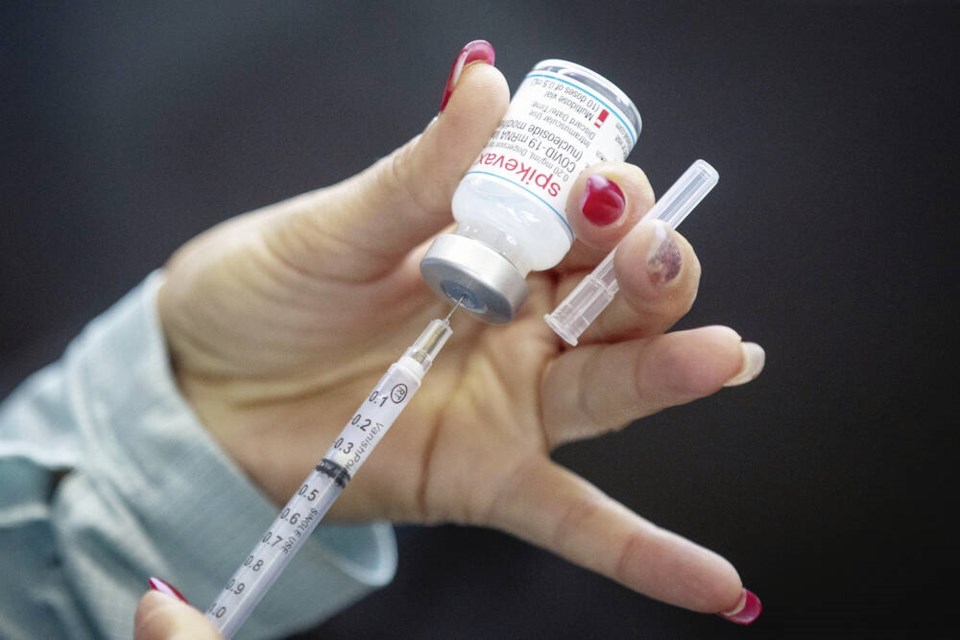The third Omicron wave has begun and is expected to increase rapidly and peak in August, says a COVID modelling expert.
“I think there was hope we wouldn’t have another wave until the fall, but the wave is starting now,” said Sally Otto, who advises masking up again, along with getting booster shots.
Otto, an evolutionary biologist and mathematical modeller at the University of British Columbia, presented her data to the main North American meeting of evolutionary biologists in Cleveland, Ohio, this past week.
Data from public health labs across Canada tracking Omicron subvariants BA.4 and BA.5 show they will soon outgrow the initial Omicron subvariants in Canada, said Otto, who is a member of the COVID-19 modelling group in B.C.
“Right now we’re in a reasonable low point, the lowest point in 2022,” Otto said in an interview. “So we can afford to be a little more relaxed right now, but not for long, because this is rising so fast that we’re going to face a higher risk.
“You go to the grocery store now and your risk is reasonably low. You go to the grocery store in three weeks and there is a high chance that somebody else will have COVID.”
Much uncertainty remains about the severity and harmfulness of subvariants BA.1 through BA.5, said Otto — at a time when public health measures are at the lowest they’ve been through the pandemic, with no mask mandate, no provincial proof of vaccination requirement for public events and gatherings, and little appetite to bring them back.
“Every week in July that passes, COVID risk is doubling and that should help give people a sense of how much more likely they are to encounter COVID in their communities,” Otto said.
“But the good news is it’s summer, so have those parties outdoors and open those windows and just avoid those crowded spaces with strangers as much as people can — and wear a mask — but don’t stop living.”
Otto recommends wearing a mask in indoor crowded environments, “especially by mid-July and August, when this next wave of cases will be in full swing.”
She also encourages those who qualify to get their COVID-19 booster shots ahead of the peak of the BA.4 and BA.5 wave and not wait for newer vaccines.
This past week, the National Advisory Committee on Immunization recommended booster shots in advance of a fall wave for people age 65 and older, long-term-care residents, people who are clinically immune-compromised, Indigenous people, and marginalized communities.
NACI said it will provide recommendations on the type of COVID-19 vaccine as evidence on appropriate vaccines becomes available.
Otto said she can’t predict whether there will be a fall wave or its expected virulence.
“What I can say is there is still enormous evolutionary potential for this virus, because there are so many cases globally and that means this virus is changing in multiple ways all around the world,” said Otto.
“I think COVID is with us in the long term and we have to kind of get better at reacting to it and responding — when the waves go up, so do all the protection measures, and when the waves come down, like we are now, in a reasonable low point … we can afford to be a little more relaxed … but not for long.”
For those losing track of the variants and subvariants, COVID-19 mutated into variants Alpha, Beta, Gamma, Delta and Omicron. Omicron is considered less deadly than Delta but more transmissible. Omicron subvariants BA.4 and BA.5 are similar to the initial Omicron subvariant BA.2, with the exception of some mutations.
“And those mutations make BA.4 and BA.5 even harder for our immune systems to recognize the virus,” said Otto.
Several countries, including the U.S., Portugal, France, Israel and Italy, have reported a rise in COVID-19 cases.
Canada’s chief public health officer Theresa Tam issued a statement Thursday saying BA.4 and BA.5 subvariants are more transmissible and are better able to evade immunity than previous versions. A rise in cases is likely in the coming weeks, she said.
As of June 18, there were an estimated 15,047 new weekly COVID-19 cases in Canada, comparable to November and down from 288,771 cases per week at the peak of the Omicron wave in January.
While numbers of COVID-19 Omicron sub-variants BA.1 and BA.2 are declining, estimated numbers of BA.4 and BA.5 are rising at a daily growth rate of 3.1 per cent in British Columbia.
By comparison in Alberta, the growth rate is 4.9 per cent, doubling every 14 days, 6.3 per cent in Ontario doubling every 11 days, and 5.5 per cent in Quebec, where it’s doubling every 12 days.
The good news is that COVID-19 Immunity Task Force and 91原创 Blood Services data suggest high levels of antibodies in all age groups as determined through blood donations through mid-May.
The bad news is that the ability of the antibodies to neutralize the COVID virus and prevent infection is substantially compromised for subvariants BA.4 and BA.5, said Otto.
>>> To comment on this article, write a letter to the editor: [email protected]



